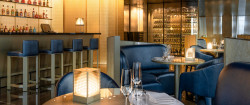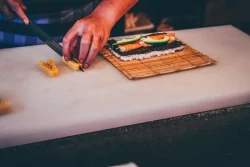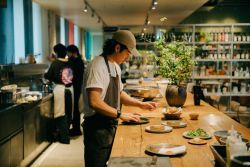
August 1, 2013
Snap, Crackle and Pop
Explore Japan’s artisanal fireworks this hanabi season
By Metropolis
Originally published on metropolis.co.jp on August 2013


It’s a cold December morning in Niigata as we leave Kamo village for the hills. We pass by fields that in the summer would be verdant with the prefecture’s major agricultural export, rice, but are now just blankets of snow.
As we wind through the palisades of cedars that line the road, the houses disappear and we become aware of an unusual sensation—being in Japan without seeing any people.
Mountains dominate 73% of Japan’s landscape. Unusable for farming and unpopular for home-building in a country based around the concept of densely concentrated residential areas, they are a haven for trees, wildlife and—these ones in particular—an often-overlooked Japanese cultural treasure: hanabi, or fireworks.
It is here, in the forested peaks that rise above the coastal plains, that the country’s 200-odd artisanal fireworks manufacturers continue an ancient craft that originated in China but was perfected in Japan. From tiny senko hanabi (sparklers) to giant ball shells, Japan’s iconic fireworks are known as some of the best in the world.
We’ve just arrived at Abe Fireworks, one of Japan’s most respected builders. We’re here to film the company’s flagship product, the legendary 36” shell, for our new documentary Passfire, the story of the people and cultures behind the world’s most amazing fireworks.
Rocket World
- China: No one does cakes—large arrays of small mortar tubes that fire as a barrage—better than the Chinese.
- Japan: Japan makes the world’s biggest and most precise ball shells, bar none.
- India: You don’t know loud until you have seen an Indian salute show. With aerial bombs weighing up to 200kg, make sure to pack earplugs.
- Malta: Cylinder shells are the European way, and Malta is the epicenter, with multi-break shells as tall as a person and a foot in diameter.
- Mexico: The Mexicans make a lot of cool rockets, but their castillos, or giant flaming murals, really stand out.
- Thailand: Have a Thai whiskey and Red Bull as you watch a homemade, 1-metric-ton (2,200lb!) rocket touch the stratosphere.
- USA: The largest number of pyrotechnic hobbyists in the world produce unique inventions such as ghost mines—mortars that belch colored balls of flaming methanol.
While touring China’s prolific fireworks factories last year, we heard tales of massive globes of flame, known as san shaku in Japanese, that weigh hundreds of pounds and can cost as much as a new car. They are so large, cranes must be used to load them into launch tubes.
There are only a handful of craftsmen in Japan that dare to build such behemoths, and like the days of master sword-makers each one is renowned for his individual style. Abe only makes one or two a month and I am lucky that today he is assembling one of the monsters.
As we watch bag after bag of black powder and stars the size of golf balls being stuffed into this pyrotechnic pumpkin, we realize this is the biggest shell we have ever seen—way bigger than anything in China.
Before making Passfire, we naively assumed that modern fireworks in Japan consisted of imported Chinese shells fired by local technicians, as is the case in many other countries. Although there certainly is some of that (at weddings and smaller occasions), the pyrotechnics forming Japan’s big firework shows are Japanese-made. Though they cost half a dozen times the price of their Chinese counterparts, the difference in workmanship is obvious.
The Japanese consider the heart of the firework to be the “star”—the small spheres of pyrotechnic composition inside the payload of a shell that catch fire and paint the night sky with streaks of color.
Japan produces some of the world’s best stars and there is little wonder as to why: while most other countries employ an efficient but fairly coarse industrial process, the Japanese approach star-rolling with the same level of patience and precision that they use for ikebana, or flower arranging.

The stars in Abe’s 36” shell take over a month to roll from start to finish and they are so precious each one is carefully wrapped in its own each one is carefully wrapped in its own piece of tissue paper. Some Japanese stars even change color, with different types of composition carefully rolled in onion-like layers on top of each other. The very best have “dark relays” that pass the fire (hence “passfire”) from one color layer to the next without producing light, so the star will first glow one color, appear to go out and then glow another.
These are techniques developed in Japan’s family-run factories since the Edo era, which are carefully passed down from master to student. We spoke with Kazuhiro Negishi, a former apprentice of Abe’s who has gone on to become a master shell builder in his own right. “Even though you get covered in dust while making stars,” Negishi explains, “there is nothing like the feeling you get when you see the joy that they create.”
Another former student of Abe’s, Shuichi Koga, has a company called Rokuyouenka whose shells contain up to six concentric layers of increasingly smaller stars that take hours—or even days—to assemble.
Despite the proximity of China, the Portuguese introduced the precursors of today’s fireworks to Japan in the 16th century. Pyrotechnics were likely brought into Europe from China some 300 years before. While the Chinese focused on firecrackers to drive away evil spirits, the Europeans developed aerial shells that burst in the sky with bright colors—but these were cylindrical in shape. It was the Japanese who perfected the spherical ball shell—the basis of today’s modern professional fireworks.
The ball shell has come to rule the world of professional fireworks displays across the globe, in large part because it can be made cheaply and efficiently in the large Chinese factories that produce 90% of the world’s fireworks.
When China opened its economy to the world after Nixon’s visit in 1972, fireworks became one of its first exports. The low cost of labor, a favorable exchange rate, permissive safety standards, and a long tradition of fireworks, allowed China to become the world’s top manufacturer in only a few decades. However, large amounts of foreign expertise were necessary and much came from Japan, with many Chinese techs going east to learn the Japanese art while Japanese companies invested in Chinese factories.
This shift, coupled with an increased regulatory burden, spelled the virtual end of manufacturing in Western countries like the US, Canada, England and Australia, but Japan was an exception. Its grandfather clauses, protected markets, and cultural affinity for perfection allowed its manufacturers to survive, with one important caveat: they don’t export.
With few exceptions, Japan’s fireworks are for domestic use only. That means if you want to see what many pyrotechnicians consider to be the world’s finest ball shells, you will have to see them in Japan.
Luckily, summer is Japan’s fireworks season and the country boasts some of the world’s most spectacular festivals. And unlike the world’s other large festivals that are based on overt competition, Japan’s tend to be a boutique demonstration of the country’s finest produce.

Take for example the king-daddy, September’s Katakai Festival in Niigata, where they shoot 48” shells—the biggest commercially produced shells in the world. Fireworks companies from across Japan gather to launch some of the world’s most expensive specimens. Participants may only shoot a couple shells a piece, and the beauty of individual shells—not the overall choreography of the show (or choice of music)—determines performance. Japanese people are very aware of what sets their fireworks apart from others—vivid colors that change as the stars burn and almost perfectly symmetrical bursts.
Listen carefully at a summer display and you may hear shouts of “Tamaya” as spectators cheer on particularly beautiful shells. Tamaya Seikichi was an Edo-era fireworker known across Japan for his talent, and spectators call his name as a nod of approval. There is even an anime series called Oh! Edo Rocket based on his exploits and to this day many Japanese fireworks companies have “Tamaya” in their name as a tribute to his greatness.
Compared to China, none of Japan’s factories can be considered big, and even Abe’s—which is large by Japanese standards—still has an intimate feel.
Workers know each other well, and many, especially in the small factories, are related. They take tea together and share the work of preparing lunch. Tasks are often divided by sex, with men mixing chemicals and assembling shells, and women pasting them once they are built. In many factories making fireworks is a multi-generational affair, with knowledge passed on father to son.
Katsushi Haga, of Haga Firworks, is an example. He is the 19th generation of a family that has worked with gunpowder since the Edo era. His ancestors originally started as armorers, making some of Japan’s early black-powder muskets, and then branched out into fireworks. To this day, part of the family still runs a gun shop—a rare sight in Japan—with a firing range behind their fireworks factory.
Religion also plays an important role in Japanese fireworks. In addition to religious interpretations of the pyrotechnics, factories often have a Shinto shrine, or even a torii (red gate), such as at Haga’s, where workers will pray for safety on a daily basis. Every New Year a priest will bless the factory for continued well-being in the coming year.
Most people only encounter fireworks a couple times a year during special occasions and the vast majority of those are made in China—but the globe’s pyro connoisseurs recognize the features that make Japan’s fireworks unique.
With summer in full swing and festivals running until November, this is an excellent time to check out Japan’s revered, cultural treasure of hanabi.
The Veverka brothers’ documentary Passfire, on the world’s most amazing fireworks, will be released in 2015. Follow the film’s production at www.facebook.com/passfire
Fire Diary
Aug 2-3, Nagaoka, Niigata
http://nagaokamatsuri.com
One of the biggest fireworks festivals in Japan, with huge shells up to 36”
Aug 11, Tohoku Region
http://lightupnippon.jp
Shells up to 12” lift the spirits of people who suffered through the Tohoku tragedy
Aug 24, Omagari, Akita
www.oomagari-hanabi.com
Omagari is one of the most famous fireworks competitions with high-quality shells up to 12”
Sep 9-10, Ojiya, Niigata
http://katakaimachi-enkakyokai.info
The Katakai fireworks show is famous for having the largest aerial shells, up to 48”!
Oct 5, Tsuchiura, Ibaraki
http://tsuchiura-hanabi.jp
Japan’s other famous competition with specialty shells up to 12”
Nov 23, Nagano
www.nagano-cci.or.jp/ebisukou
High-quality shells up to 12”







